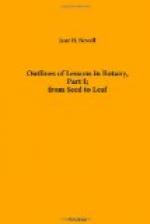Briefly, the theory is this: the beginnings of leaf, petal, tendril, etc., are the same. At an early stage of their growth it is impossible to tell what they are to become. They develop into the organ needed for the particular work required of them to do. The organ, that under other circumstances might develop into a leaf, is capable of developing into a petal, a stamen, or a pistil, according to the requirements of the plant, but no actual metamorphosis takes place. Sometimes, instead of developing into the form we should normally find, the organ develops into another form, as when a petal stands in the place of a stamen, or the pistil reverts to a leafy branch. This will be more fully treated under flowers. The study of the different forms in which an organ may appear is the study of morphology.
1. Forms of Stems.—Stems may grow in many ways. Let the pupils compare the habits of growth of the seedlings they have studied. The Sunflower and Corn are erect. This is the most usual habit, as with our common trees. The Morning Glory is twining, the stem itself twists about a support. The Bean, Pea and Nasturtium are climbing. The stems are weak, and are held up, in the first two by tendrils, in the last by the twining leaf-stalks. The English Ivy, as we have seen, is also climbing, by means of its aerial roots. The Red Clover is ascending, the branches rising obliquely from the base. Some kinds of Clover, as the White Clover, are creeping, that is, with prostrate branches rooting at the nodes and forming new plants. Such rooting branches are called stolons, or when the stem runs underground, suckers. The gardener imitates them in the process called layering, that is, bending down an erect branch and covering it with soil, causing it to strike root. When the connecting stem is cut, a new plant is formed. Long and leafless stolons, like those of the Strawberry are called runners. Stems creep below the ground as well as above. Probably the pupil will think of some examples. The pretty little Gold Thread is so named from the yellow running stems, which grow beneath the ground and send up shoots, or suckers, which make new plants. Many grasses propagate themselves in this way. Such stems are called rootstocks. “That these are really stems, and not roots, is evident from the way in which they grow; from their consisting of a succession of joints; and from the leaves which they bear on each node, in the form of small scales, just like the lowest ones on the upright stem next the ground. They also produce buds in the axils of these scales, showing the scales to be leaves; whereas real roots bear neither leaves nor axillary buds."[1] Rootstocks are often stored with nourishment. We have already taken up this subject in the potato, but it is well to repeat the distinction between stems and roots. A thick, short rootstock provided with buds, like the potato, is called a tuber. Compare again the corm of Crocus and the bulb of Onion to find the stem in each. In the former, it makes the bulk of the whole; in the latter, it is a mere plate holding the fleshy bases of the leaves.




